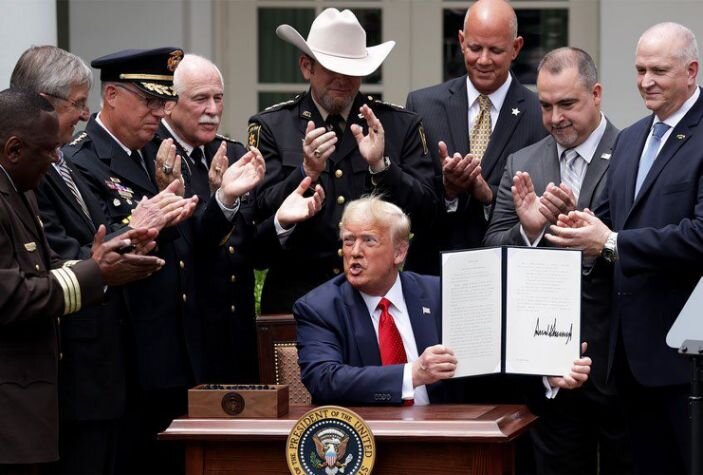The History of 'Law and Order' Politics & What it Means in the 2020 Election
Surrounded by members of law enforcement, U.S. President Donald Trump holds up an executive order he signed on “Safe Policing for Safe Communities” during an event in the Rose Garden at the White House June 16, 2020 in Washington, DC. Source.
On multiple occasions over his four year term, Donald Trump has claimed he is the president of “Law and Order.” He has incorporated this phrase into many tweets, speeches, and campaign messages. In 2016, Trump ran as the “Law and Order candidate,” and he is continuing that strategy into the 2020 election. In fact, in the first Presidential Debate alone, Trump talked about law and order at least seven times. However, this broad phrase is not usually followed by any concrete explanation, which is vital to understanding what it truly means.
The phrase “law and order” has a long history in American politics beginning in the early 1960s during Barry Goldwater’s campaign for president. However, the first time it was used successfully was by former President Richard Nixon during the 1968 presidential election — following significant acts of civil unrest. During this time, race riots occurred throughout the country and protests over the Vietnam war took place across many college campuses in the US. Nixon marketed himself as someone who would uphold laws and restore order to bring the country back to normalcy. Nixon also used this rhetoric to crack down on drug users in America, officially starting the War on Drugs in the early 1970s. Many of the resulting policies largely targeted minority communities. For example, high mandatory minimum sentencing for certain drugs (that were mostly used by minority communities) were put in place, while others had low or no minimum sentences. Crime rates still rose, leading to many other policies that are still in place today. One of the more notable laws enacted during this time is the 1994 Violent Crime Control and Law Enforcement Act (also referred to as the 1994 Crime Bill), which was led by then-senator Joe Biden. The bill changed the nation's punitive landscape, including funding more prisons and more policing, encouraging tougher sentencing and more drug related arrests, as well as providing more resources to help women in domestic violence and sexual assault cases and funding background checks for gun buyers. Both this law and many of the Nixonian War on Drugs policies have greatly contributed to the disproportionate incarceration and policing of minorities. Rates of violent crime did fall after these measures were put in place, but the negative effects of these policies still serve to harm racial minorities in America today.
The phrase had subsided in recent years. However, law and order has been reintroduced into presidential politics by Donald Trump. In recent months, protests over the death of George Floyd and the general systemic racism present in America’s institutions have resulted in tension around the country that has sometimes resulted in violence. Trump has claimed numerous times that this violence is due to democratic state and local officials that refuse to enforce law and order. His response has been to strongly encourage them to call the National Guard or for officials to be harder on the protestors. Trump has been clear that he supports law enforcement as it currently stands. He has increased funding with suggestions for minor reform and increased the amount of military equipment available for officials. However, data clearly shows that police violence happens at a much higher rate to minorities than to White Americans.
Joe Biden’s stance is a bit different and has heavily shifted over the years. The aforementioned 1994 Crime Bill was championed by Biden. This law did contribute and encourage the mass incarceration of Black Americans that still occurs today. It also provided a lot more funding to law enforcement officers with little to no reform. However, in recent years, Biden has turned to highlight the positive aspects of the law while recognizing the racism embedded in the institutions that enforce them. During the first presidential debate, Trump asked Biden whether he supported law and order. He answered he “supports law and order while people get treated fairly.” Biden goes on to explain he aims to reform the criminal justice system by reforming drug laws, abolishing for- profit prisons, and addressing systemic racism.
Considering the origins and deployment of the very utterance “Law and Order,” it is clear that this slogan is used to tap into fears surrounding protests, crime, and nonwhite people, which subsequently justifies legislation that targets nonwhite communities. While law and order has been a big talking point for President Trump, it is unclear whether voters will buy his arguments or shift to Biden’s more pluralistic framework.

